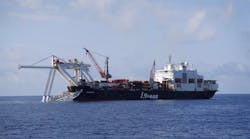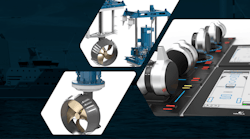Offshore West Africa is a sea of opportu-nity for support vessel fleets. Unprecedented development activity led to 30 boats being drafted to the region last year, swelling the overall pool of plat-form supply vessels (PSVs), tugs, anchor-handlers, and crew boats to 304.
null
Seabulk Offshore, based in Nyon, Switzer-land, is one of the more committed operators. The company ranks second in West Africa behind the clear market leader, Tidewater, with 43 dedicated vessels in this region. Its most recent addition is the Seabulk Africa, its sixth PSV for this market and also its first new PSV since 2000. At that time, parent group Seabulk International (headquartered in Florida) was undergoing restructuring under new management, following a period of heavy losses.
The downturn has since been reversed, and the Seabulk Offshore division today owns the world's largest offshore fleet, comprising around 135 vessels. The new management is taking a long-term view, recognizing that some of its older vessels need to be upgraded or replaced. Aside from the Seabulk Africa, the company has commissioned two more new PSVs for Far East operations. It is also open to growth through acquisition of a rival contractor's fleet. Some PSV tonnage is known to be available in the Gulf of Mexico, according to Anthony Weller, vice president of chartering.
Seabulk Africa, which was presented in February to Seabulk's clients in Aberdeen, is a UT-755L design, targeted at deepwater support operations. Gulf Marine had originally ordered it for harsh environment duty in the North Sea and offshore Canada. Seabulk Offshore specified certain changes to meet West African deepwater requirements, including a class 1 dynamic positioning (DP) system sufficient for station-keeping and light ROV deployment, a rescue zone, and Fi-Fi firefighting capability. Weller says the major operators are increasingly loath to delegate firefighting to shore-based standby vessels, which has been the traditional approach around West Africa.
The new vessel is 236-ft long, with a deck area of 51 x 13.5 m, and a submerged deadweight of 3,350 tons. It can accommodate a crew of up to 26.
"There is a growing trend off West Africa for larger PSVs to replace the smaller vessels," Weller says, "due partly to their higher storage capabilities."
Seabulk Africa can handle 200 cu m of base oil, 390 cu m of brine, almost 1,000 cu m of liquid mud, and over 1,000 cu m of fuel oil.
"This is advantageous when supporting a DP drillship," he points out, "which will typically consume a lot of fuel."
The vessel's large liquid mud tanks can also be used to convey waste mud back to the shore. Although modern drillships have mud-recycling facilities onboard, this is not always the case with deepwater semisubmersibles off West Africa, which often operate long distances from mainland service bases. In line with the international trend toward better environmental practices, the Seabulk Africa's liquid mud tanks have also been designed to be self-washing, following transfer of sludge to a slop tank.
Last month, the vessel was in Onni port in Nigeria, where it was being evaluated by several major oil companies. One prospective project could be Kizomba Phase II in Angola block 15.
"ExxonMobil already uses a couple of PSVs this size to support its Jade field development drilling off Equatorial Guinea," Weller says. "We are also in discussions with one client on taking the Seabulk Africa as their platform's main PSV under a multi-year contract, while they retain shore-based anchor-handlers to support associated rig moves."
Deepwater drilling rigs are in demand in frontier regions in particular. Seabulk has recently supported operations by Kerr-McGee off Benin and by Woodside off Mauritania.
"Our other targeted growth area is FPSO terminal support. We have a number of bids out with Total and ExxonMobil for berthing of export tankers, encompassing firefighting, and other standby duties. We're already doing this type of work for the Odudu field offshore Nigeria. Additionally, we provided assistance in the recent installations of the Abo FPSO (also Nigeria), and the Etame FPSO off Gabon.
"Another new development in West Africa is the demand for fast supply vessels that can travel at 22-25 knots, against the current norm of 12-14 knots. We have in mind a few 150-ft long vessels built in 1998 that we could bring in from the USA."
Recently, the company also took delivery in Singapore of two newbuilds from the Labroy Shipbuilding & Engineering yard in Batan, Indonesia. Seabulk Offshore will operate the first of these, the Seabulk Nilar, which is a 50-m long, 3,900-hp PSV, under a bareboat charter to Total, supporting production operations off Myanmar. Its advanced features include sophisticated firefighting and anti-pollution equipment, the company claims. The Seabulk Badamyar is an anchor-handling/tug supply vessel featuring twin-screw marine diesel engines, each driving a variable-pitch propeller via an azimuthing stern thruster drive. This will also work for Total under the same three-year arrangement, with options for a further two years.
"We previously had the contract for this project five years ago," Weller says, "then lost it to Tidewater for three years; however, when the latest call to tender was issued, Total announced it wanted newbuildings. These two vessels took 14 months to build. In the meantime, we supplied support vessels from our existing fleet in the Far East."







